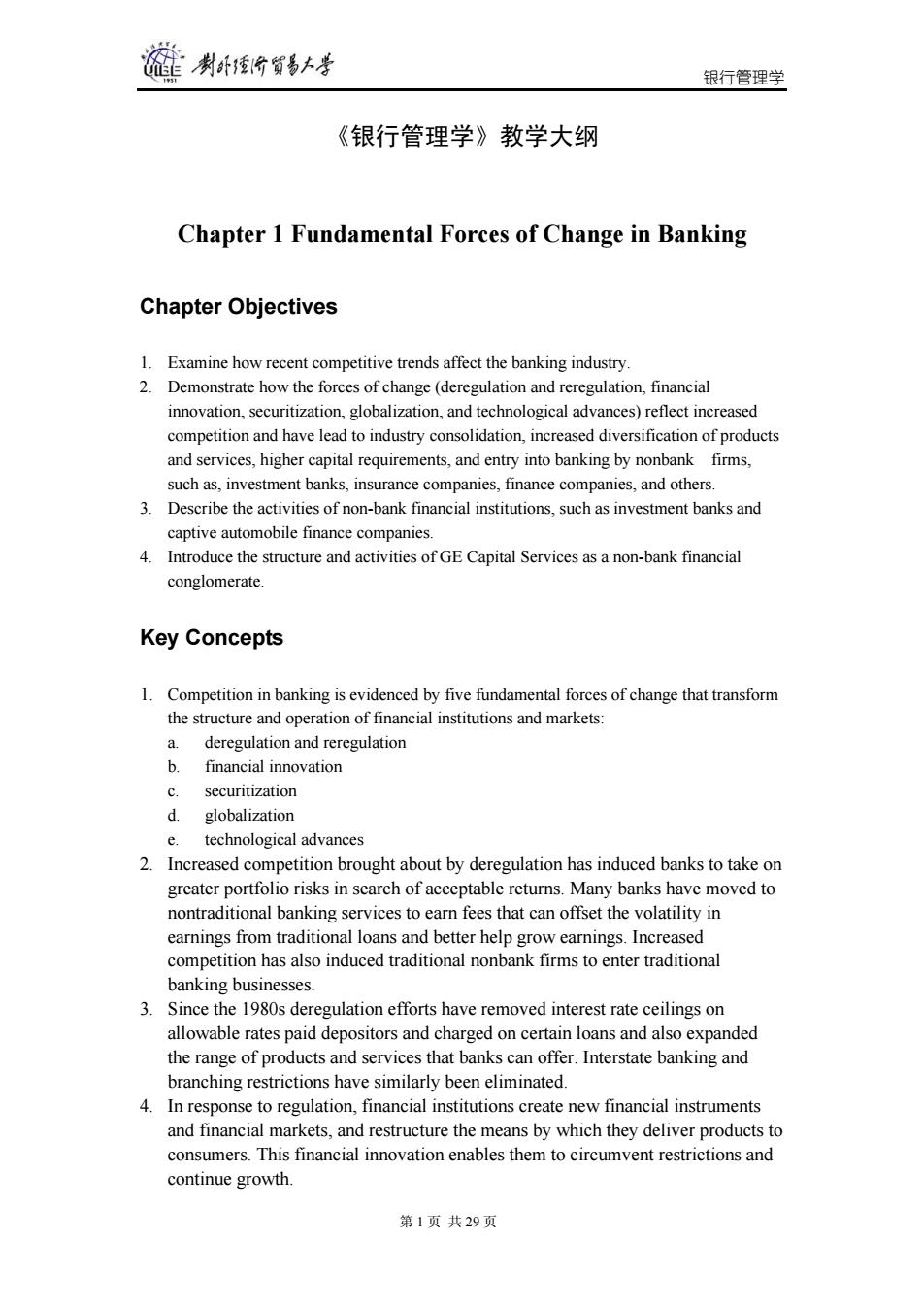
溢 制卧爱分贸多本芳 银行管理学 《银行管理学》教学大纲 Chapter 1 Fundamental Forces of Change in Banking Chapter Objectives 1.Examine how recent competitive trends affect the banking industry. 2.Demonstrate how the forces of change(deregulation and reregulation,financial innovation,securitization,globalization,and technological advances)reflect increased competition and have lead to industry consolidation,increased diversification of products and services,higher capital requirements,and entry into banking by nonbank firms, such as,investment banks,insurance companies,finance companies,and others. 3.Describe the activities of non-bank financial institutions,such as investment banks and captive automobile finance companies. 4.Introduce the structure and activities of GE Capital Services as a non-bank financial conglomerate Key Concepts 1.Competition in banking is evidenced by five fundamental forces of change that transform the structure and operation of financial institutions and markets: a. deregulation and reregulation b. financial innovation c. securitization d. globalization e.technological advances 2.Increased competition brought about by deregulation has induced banks to take on greater portfolio risks in search of acceptable returns.Many banks have moved to nontraditional banking services to earn fees that can offset the volatility in earnings from traditional loans and better help grow earnings.Increased competition has also induced traditional nonbank firms to enter traditional banking businesses. 3.Since the 1980s deregulation efforts have removed interest rate ceilings on allowable rates paid depositors and charged on certain loans and also expanded the range of products and services that banks can offer.Interstate banking and branching restrictions have similarly been eliminated. 4.In response to regulation,financial institutions create new financial instruments and financial markets,and restructure the means by which they deliver products to consumers.This financial innovation enables them to circumvent restrictions and continue growth. 第1页共29页
银行管理学 第 1 页 共 29 页 《银行管理学》教学大纲 Chapter 1 Fundamental Forces of Change in Banking Chapter Objectives 1. Examine how recent competitive trends affect the banking industry. 2. Demonstrate how the forces of change (deregulation and reregulation, financial innovation, securitization, globalization, and technological advances) reflect increased competition and have lead to industry consolidation, increased diversification of products and services, higher capital requirements, and entry into banking by nonbank firms, such as, investment banks, insurance companies, finance companies, and others. 3. Describe the activities of non-bank financial institutions, such as investment banks and captive automobile finance companies. 4. Introduce the structure and activities of GE Capital Services as a non-bank financial conglomerate. Key Concepts 1. Competition in banking is evidenced by five fundamental forces of change that transform the structure and operation of financial institutions and markets: a. deregulation and reregulation b. financial innovation c. securitization d. globalization e. technological advances 2. Increased competition brought about by deregulation has induced banks to take on greater portfolio risks in search of acceptable returns. Many banks have moved to nontraditional banking services to earn fees that can offset the volatility in earnings from traditional loans and better help grow earnings. Increased competition has also induced traditional nonbank firms to enter traditional banking businesses. 3. Since the 1980s deregulation efforts have removed interest rate ceilings on allowable rates paid depositors and charged on certain loans and also expanded the range of products and services that banks can offer. Interstate banking and branching restrictions have similarly been eliminated. 4. In response to regulation, financial institutions create new financial instruments and financial markets, and restructure the means by which they deliver products to consumers. This financial innovation enables them to circumvent restrictions and continue growth
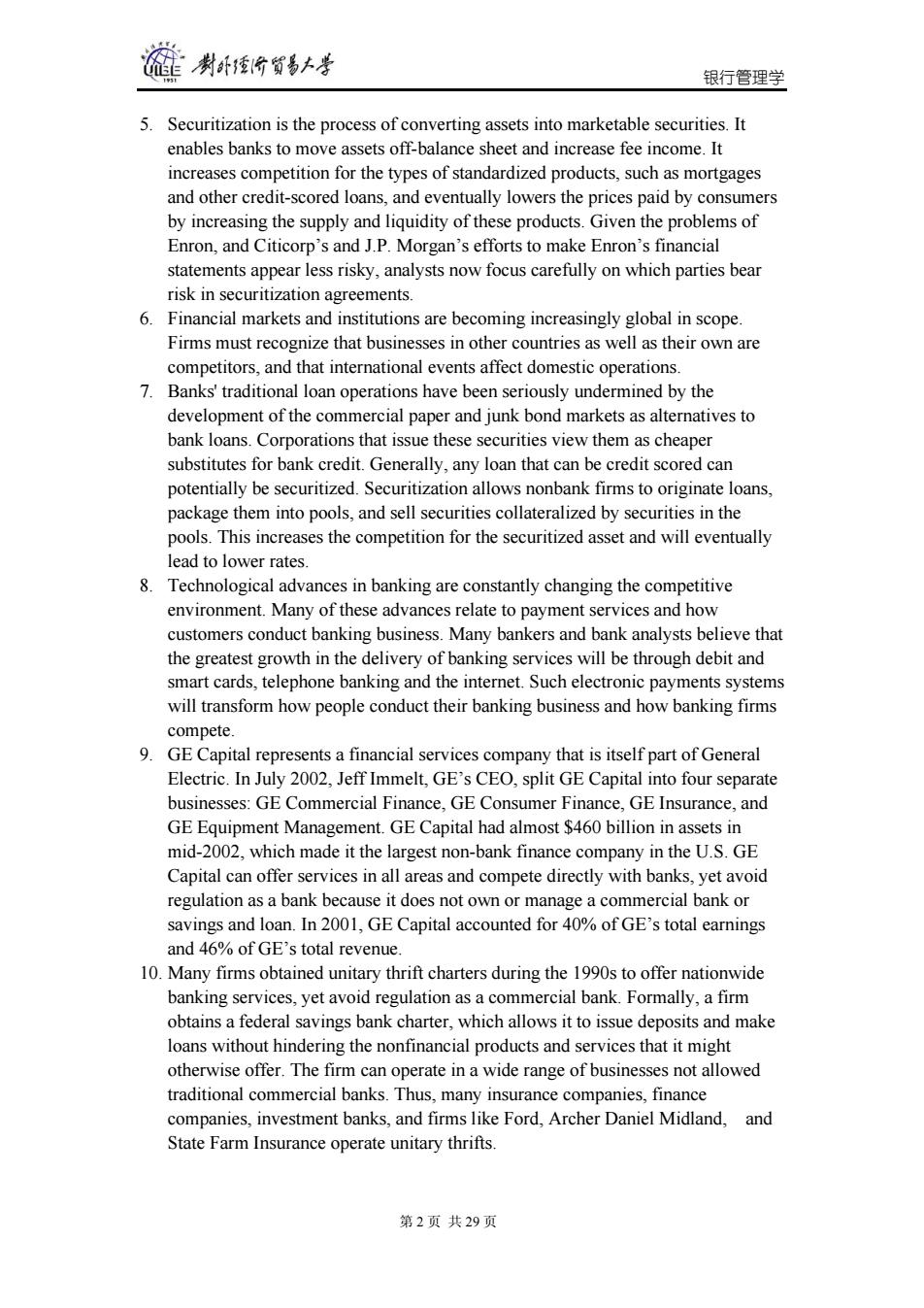
制卧份贸易+学 银行管理学 5. Securitization is the process of converting assets into marketable securities.It enables banks to move assets off-balance sheet and increase fee income.It increases competition for the types of standardized products,such as mortgages and other credit-scored loans,and eventually lowers the prices paid by consumers by increasing the supply and liquidity of these products.Given the problems of Enron,and Citicorp's and J.P.Morgan's efforts to make Enron's financial statements appear less risky,analysts now focus carefully on which parties bear risk in securitization agreements. 6.Financial markets and institutions are becoming increasingly global in scope. Firms must recognize that businesses in other countries as well as their own are competitors,and that international events affect domestic operations. 7.Banks'traditional loan operations have been seriously undermined by the development of the commercial paper and junk bond markets as alternatives to bank loans.Corporations that issue these securities view them as cheaper substitutes for bank credit.Generally,any loan that can be credit scored can potentially be securitized.Securitization allows nonbank firms to originate loans, package them into pools,and sell securities collateralized by securities in the pools.This increases the competition for the securitized asset and will eventually lead to lower rates. 8.Technological advances in banking are constantly changing the competitive environment.Many of these advances relate to payment services and how customers conduct banking business.Many bankers and bank analysts believe that the greatest growth in the delivery of banking services will be through debit and smart cards,telephone banking and the internet.Such electronic payments systems will transform how people conduct their banking business and how banking firms compete. 9.GE Capital represents a financial services company that is itself part of General Electric.In July 2002,Jeff Immelt,GE's CEO,split GE Capital into four separate businesses:GE Commercial Finance,GE Consumer Finance,GE Insurance,and GE Equipment Management.GE Capital had almost $460 billion in assets in mid-2002,which made it the largest non-bank finance company in the U.S.GE Capital can offer services in all areas and compete directly with banks,yet avoid regulation as a bank because it does not own or manage a commercial bank or savings and loan.In 2001,GE Capital accounted for 40%of GE's total earnings and 46%of GE's total revenue. 10.Many firms obtained unitary thrift charters during the 1990s to offer nationwide banking services,yet avoid regulation as a commercial bank.Formally,a firm obtains a federal savings bank charter,which allows it to issue deposits and make loans without hindering the nonfinancial products and services that it might otherwise offer.The firm can operate in a wide range of businesses not allowed traditional commercial banks.Thus,many insurance companies,finance companies,investment banks,and firms like Ford,Archer Daniel Midland,and State Farm Insurance operate unitary thrifts. 第2页共29页
银行管理学 第 2 页 共 29 页 5. Securitization is the process of converting assets into marketable securities. It enables banks to move assets off-balance sheet and increase fee income. It increases competition for the types of standardized products, such as mortgages and other credit-scored loans, and eventually lowers the prices paid by consumers by increasing the supply and liquidity of these products. Given the problems of Enron, and Citicorp’s and J.P. Morgan’s efforts to make Enron’s financial statements appear less risky, analysts now focus carefully on which parties bear risk in securitization agreements. 6. Financial markets and institutions are becoming increasingly global in scope. Firms must recognize that businesses in other countries as well as their own are competitors, and that international events affect domestic operations. 7. Banks' traditional loan operations have been seriously undermined by the development of the commercial paper and junk bond markets as alternatives to bank loans. Corporations that issue these securities view them as cheaper substitutes for bank credit. Generally, any loan that can be credit scored can potentially be securitized. Securitization allows nonbank firms to originate loans, package them into pools, and sell securities collateralized by securities in the pools. This increases the competition for the securitized asset and will eventually lead to lower rates. 8. Technological advances in banking are constantly changing the competitive environment. Many of these advances relate to payment services and how customers conduct banking business. Many bankers and bank analysts believe that the greatest growth in the delivery of banking services will be through debit and smart cards, telephone banking and the internet. Such electronic payments systems will transform how people conduct their banking business and how banking firms compete. 9. GE Capital represents a financial services company that is itself part of General Electric. In July 2002, Jeff Immelt, GE’s CEO, split GE Capital into four separate businesses: GE Commercial Finance, GE Consumer Finance, GE Insurance, and GE Equipment Management. GE Capital had almost $460 billion in assets in mid-2002, which made it the largest non-bank finance company in the U.S. GE Capital can offer services in all areas and compete directly with banks, yet avoid regulation as a bank because it does not own or manage a commercial bank or savings and loan. In 2001, GE Capital accounted for 40% of GE’s total earnings and 46% of GE’s total revenue. 10. Many firms obtained unitary thrift charters during the 1990s to offer nationwide banking services, yet avoid regulation as a commercial bank. Formally, a firm obtains a federal savings bank charter, which allows it to issue deposits and make loans without hindering the nonfinancial products and services that it might otherwise offer. The firm can operate in a wide range of businesses not allowed traditional commercial banks. Thus, many insurance companies, finance companies, investment banks, and firms like Ford, Archer Daniel Midland, and State Farm Insurance operate unitary thrifts
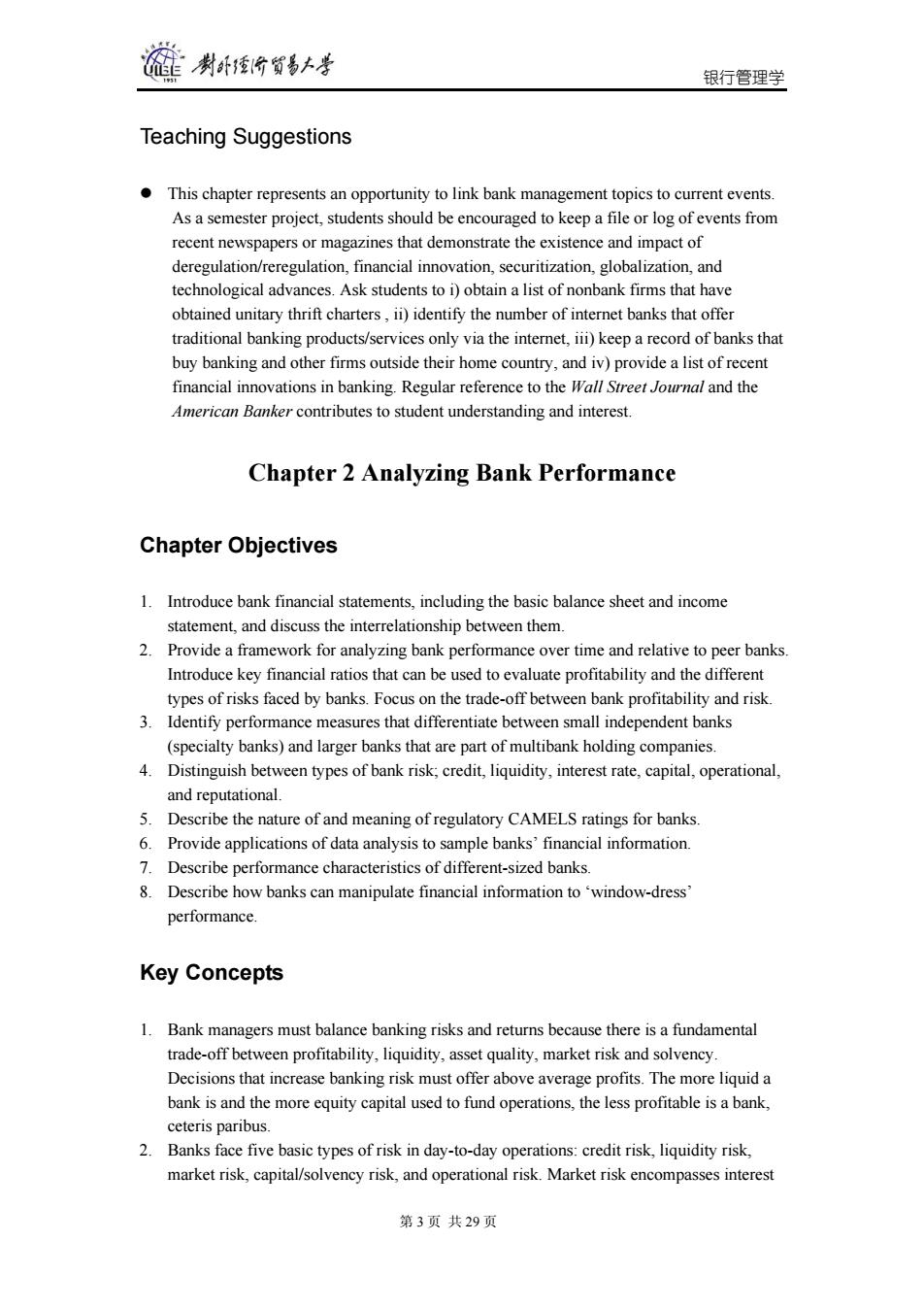
雄 制卧台贸多上考 银行管理学 Teaching Suggestions This chapter represents an opportunity to link bank management topics to current events. As a semester project,students should be encouraged to keep a file or log of events from recent newspapers or magazines that demonstrate the existence and impact of deregulation/reregulation,financial innovation,securitization,globalization,and technological advances.Ask students to i)obtain a list of nonbank firms that have obtained unitary thrift charters,ii)identify the number of internet banks that offer traditional banking products/services only via the internet,iii)keep a record of banks that buy banking and other firms outside their home country,and iv)provide a list of recent financial innovations in banking.Regular reference to the Wall Street Journal and the American Banker contributes to student understanding and interest. Chapter 2 Analyzing Bank Performance Chapter Objectives 1.Introduce bank financial statements,including the basic balance sheet and income statement,and discuss the interrelationship between them. 2.Provide a framework for analyzing bank performance over time and relative to peer banks. Introduce key financial ratios that can be used to evaluate profitability and the different types of risks faced by banks.Focus on the trade-off between bank profitability and risk. 3.Identify performance measures that differentiate between small independent banks (specialty banks)and larger banks that are part of multibank holding companies. 4.Distinguish between types of bank risk,credit,liquidity,interest rate,capital,operational, and reputational. 5.Describe the nature of and meaning of regulatory CAMELS ratings for banks. 6. Provide applications of data analysis to sample banks'financial information. 7.Describe performance characteristics of different-sized banks. 8. Describe how banks can manipulate financial information to 'window-dress performance. Key Concepts 1.Bank managers must balance banking risks and returns because there is a fundamental trade-off between profitability,liquidity,asset quality,market risk and solvency. Decisions that increase banking risk must offer above average profits.The more liquid a bank is and the more equity capital used to fund operations,the less profitable is a bank, ceteris paribus. 2.Banks face five basic types of risk in day-to-day operations:credit risk,liquidity risk, market risk,capital/solvency risk,and operational risk.Market risk encompasses interest 第3页共29页
银行管理学 第 3 页 共 29 页 Teaching Suggestions z This chapter represents an opportunity to link bank management topics to current events. As a semester project, students should be encouraged to keep a file or log of events from recent newspapers or magazines that demonstrate the existence and impact of deregulation/reregulation, financial innovation, securitization, globalization, and technological advances. Ask students to i) obtain a list of nonbank firms that have obtained unitary thrift charters , ii) identify the number of internet banks that offer traditional banking products/services only via the internet, iii) keep a record of banks that buy banking and other firms outside their home country, and iv) provide a list of recent financial innovations in banking. Regular reference to the Wall Street Journal and the American Banker contributes to student understanding and interest. Chapter 2 Analyzing Bank Performance Chapter Objectives 1. Introduce bank financial statements, including the basic balance sheet and income statement, and discuss the interrelationship between them. 2. Provide a framework for analyzing bank performance over time and relative to peer banks. Introduce key financial ratios that can be used to evaluate profitability and the different types of risks faced by banks. Focus on the trade-off between bank profitability and risk. 3. Identify performance measures that differentiate between small independent banks (specialty banks) and larger banks that are part of multibank holding companies. 4. Distinguish between types of bank risk; credit, liquidity, interest rate, capital, operational, and reputational. 5. Describe the nature of and meaning of regulatory CAMELS ratings for banks. 6. Provide applications of data analysis to sample banks’ financial information. 7. Describe performance characteristics of different-sized banks. 8. Describe how banks can manipulate financial information to ‘window-dress’ performance. Key Concepts 1. Bank managers must balance banking risks and returns because there is a fundamental trade-off between profitability, liquidity, asset quality, market risk and solvency. Decisions that increase banking risk must offer above average profits. The more liquid a bank is and the more equity capital used to fund operations, the less profitable is a bank, ceteris paribus. 2. Banks face five basic types of risk in day-to-day operations: credit risk, liquidity risk, market risk, capital/solvency risk, and operational risk. Market risk encompasses interest

制卧台贸易上兰 银行管理学 rate risk,foreign exchange risk and price risk.Each type of risk refers to the potential variation in a bank's net income or market value of stockholders'equity resulting from problems that affect that part of the bank's activities. 3.Banks also face risks in the areas of country risk associated with loans or other activity with foreign government units and off-balance sheet activities,which create contingent liabilities.More recently,banks have focused on reputation risk.For example,in 2002 Citigroup found that even though it continued to report strong profits,the firm experienced strong criticism for 1)its role in facilitating strategies to disguise Enron's true financial status,2)problems in its sub-prime lending programs via the Associates and its own internal finance company activities,and 3)problems with its Salomon Smith Barney subsidiary with analyst conflicts between stock reports and the firm's investment banking relationships.For much of 2002,Citigroup's stock price reflected the continued barrage of reputation problems more than the firm's reported earnings. 4.A bank's return on equity(ROE)can be decomposed in terms of the duPont system of financial ratio analysis.This examination of historical balance sheet and income statement data enables an analyst to evaluate the comparative strengths and weaknesses of performance over time and versus peer banks.The Uniform Bank Performance Report (UBPR)data reflect the basic ratios from this return on equity model. 5. Different-sized commercial banks exhibit different operating characteristics and thus performance measures.Small banks typically report a higher return on assets(ROA)than large banks because they earn higher gross yields on assets and pay less interest on liabilities. 6.High performance banks generally benefit from lower interest and non-interest expense and limit credit risk so that loan losses are relatively low.They also operate with above average stockholders'equity. 7.Many banks can successfully "window-dress"performance by manipulating the reporting of financial data.They may accelerate revenue recognition and defer expenses or selectively alter when they take securities gains or losses and time when to charge off loans or report loans as non-performing.As such,they may inappropriately smooth earnings with provisions for loan losses or by other means.Analysts must be careful when evaluating extraordinary transactions that have one-time gain or loss features. Teaching Suggestions 1.It is extremely important that students fully understand the material in this chapter before attempting more difficult analysis.The text introduces actual balance sheet and income statement data for PNC Bank,the principal subsidiary of PNC Bank Corp.,and data for a hypothetical community bank that is representative of the typical independent bank.You should take a substantial amount of time to describe the basic balance sheet items. emphasizing the dominant holdings of loans,securities,and cash/cash equivalents among assets,and the role of core deposits versus noncore or purchased(hot money)liabilities. Demonstrate how the income statement is structured to emphasize the financial nature of banks by focusing on net interest income and the comparison on noninterest income and noninterest expense.Contrast this with the income statement of a nonfinancial 第4页共29页
银行管理学 第 4 页 共 29 页 rate risk, foreign exchange risk and price risk. Each type of risk refers to the potential variation in a bank's net income or market value of stockholders’ equity resulting from problems that affect that part of the bank's activities. 3. Banks also face risks in the areas of country risk associated with loans or other activity with foreign government units and off-balance sheet activities, which create contingent liabilities. More recently, banks have focused on reputation risk. For example, in 2002 Citigroup found that even though it continued to report strong profits, the firm experienced strong criticism for 1) its role in facilitating strategies to disguise Enron’s true financial status, 2) problems in its sub-prime lending programs via the Associates and its own internal finance company activities, and 3) problems with its Salomon Smith Barney subsidiary with analyst conflicts between stock reports and the firm’s investment banking relationships. For much of 2002, Citigroup’s stock price reflected the continued barrage of reputation problems more than the firm’s reported earnings. 4. A bank's return on equity (ROE) can be decomposed in terms of the duPont system of financial ratio analysis. This examination of historical balance sheet and income statement data enables an analyst to evaluate the comparative strengths and weaknesses of performance over time and versus peer banks. The Uniform Bank Performance Report (UBPR) data reflect the basic ratios from this return on equity model. 5. Different-sized commercial banks exhibit different operating characteristics and thus performance measures. Small banks typically report a higher return on assets (ROA) than large banks because they earn higher gross yields on assets and pay less interest on liabilities. 6. High performance banks generally benefit from lower interest and non-interest expense and limit credit risk so that loan losses are relatively low. They also operate with above average stockholders' equity. 7. Many banks can successfully "window-dress" performance by manipulating the reporting of financial data. They may accelerate revenue recognition and defer expenses or selectively alter when they take securities gains or losses and time when to charge off loans or report loans as non-performing. As such, they may inappropriately smooth earnings with provisions for loan losses or by other means. Analysts must be careful when evaluating extraordinary transactions that have one-time gain or loss features. Teaching Suggestions 1. It is extremely important that students fully understand the material in this chapter before attempting more difficult analysis. The text introduces actual balance sheet and income statement data for PNC Bank, the principal subsidiary of PNC Bank Corp., and data for a hypothetical community bank that is representative of the typical independent bank. You should take a substantial amount of time to describe the basic balance sheet items, emphasizing the dominant holdings of loans, securities, and cash/cash equivalents among assets, and the role of core deposits versus noncore or purchased (hot money) liabilities. Demonstrate how the income statement is structured to emphasize the financial nature of banks by focusing on net interest income and the comparison on noninterest income and noninterest expense. Contrast this with the income statement of a nonfinancial
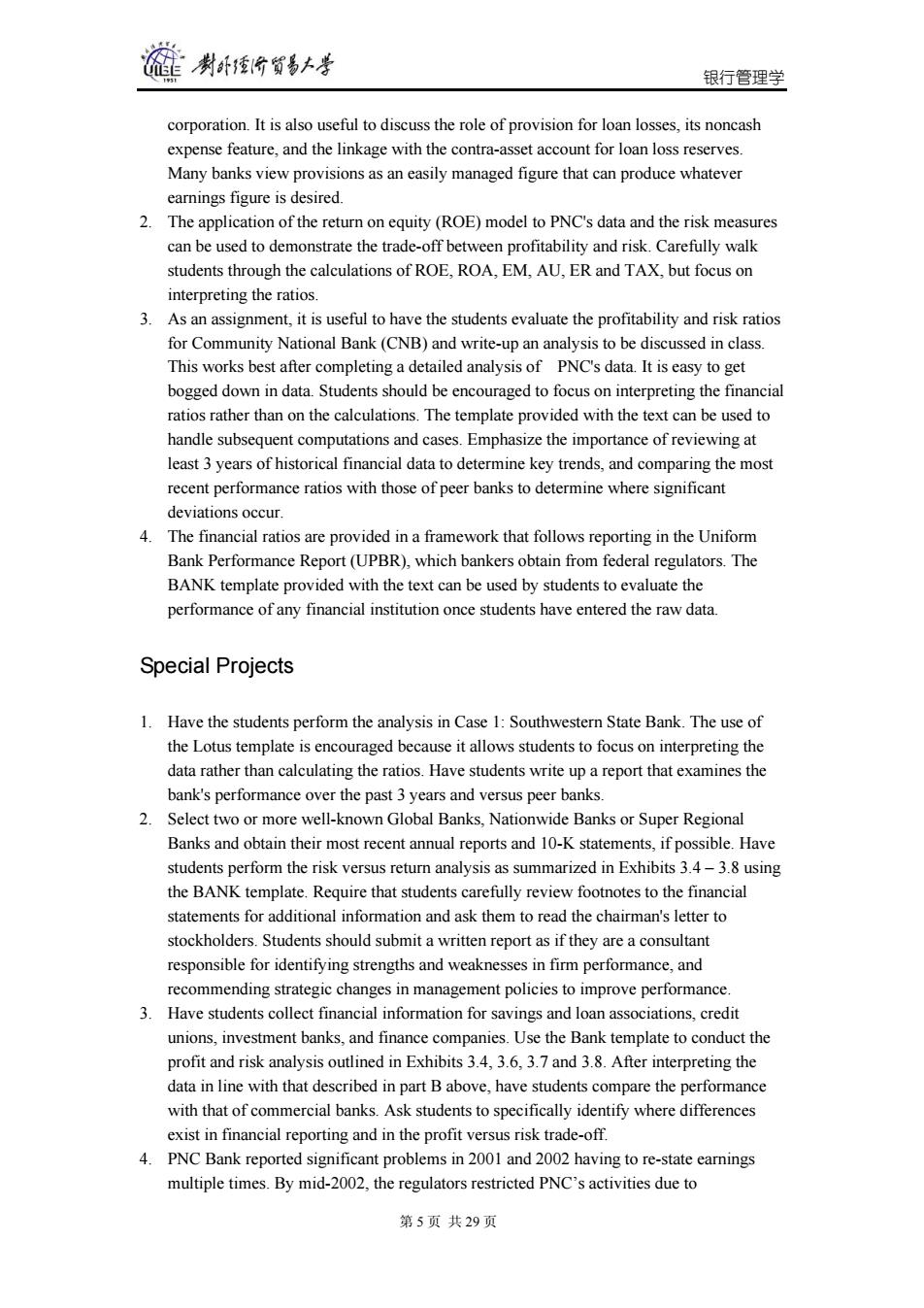
”制卧台贸易上兰 银行管理学 corporation.It is also useful to discuss the role of provision for loan losses,its noncash expense feature,and the linkage with the contra-asset account for loan loss reserves. Many banks view provisions as an easily managed figure that can produce whatever earnings figure is desired. 2.The application of the return on equity(ROE)model to PNC's data and the risk measures can be used to demonstrate the trade-off between profitability and risk.Carefully walk students through the calculations of ROE,ROA,EM,AU,ER and TAX,but focus on interpreting the ratios. 3.As an assignment,it is useful to have the students evaluate the profitability and risk ratios for Community National Bank(CNB)and write-up an analysis to be discussed in class. This works best after completing a detailed analysis of PNC's data.It is easy to get bogged down in data.Students should be encouraged to focus on interpreting the financial ratios rather than on the calculations.The template provided with the text can be used to handle subsequent computations and cases.Emphasize the importance of reviewing at least 3 years of historical financial data to determine key trends,and comparing the most recent performance ratios with those of peer banks to determine where significant deviations occur. 4.The financial ratios are provided in a framework that follows reporting in the Uniform Bank Performance Report(UPBR),which bankers obtain from federal regulators.The BANK template provided with the text can be used by students to evaluate the performance of any financial institution once students have entered the raw data. Special Projects 1.Have the students perform the analysis in Case 1:Southwestern State Bank.The use of the Lotus template is encouraged because it allows students to focus on interpreting the data rather than calculating the ratios.Have students write up a report that examines the bank's performance over the past 3 years and versus peer banks. 2.Select two or more well-known Global Banks,Nationwide Banks or Super Regional Banks and obtain their most recent annual reports and 10-K statements,if possible.Have students perform the risk versus return analysis as summarized in Exhibits 3.4-3.8 using the BANK template.Require that students carefully review footnotes to the financial statements for additional information and ask them to read the chairman's letter to stockholders.Students should submit a written report as if they are a consultant responsible for identifying strengths and weaknesses in firm performance,and recommending strategic changes in management policies to improve performance. 3.Have students collect financial information for savings and loan associations,credit unions,investment banks,and finance companies.Use the Bank template to conduct the profit and risk analysis outlined in Exhibits 3.4,3.6,3.7 and 3.8.After interpreting the data in line with that described in part B above,have students compare the performance with that of commercial banks.Ask students to specifically identify where differences exist in financial reporting and in the profit versus risk trade-off. 4.PNC Bank reported significant problems in 2001 and 2002 having to re-state earnings multiple times.By mid-2002.the regulators restricted PNC's activities due to 第5页共29页
银行管理学 第 5 页 共 29 页 corporation. It is also useful to discuss the role of provision for loan losses, its noncash expense feature, and the linkage with the contra-asset account for loan loss reserves. Many banks view provisions as an easily managed figure that can produce whatever earnings figure is desired. 2. The application of the return on equity (ROE) model to PNC's data and the risk measures can be used to demonstrate the trade-off between profitability and risk. Carefully walk students through the calculations of ROE, ROA, EM, AU, ER and TAX, but focus on interpreting the ratios. 3. As an assignment, it is useful to have the students evaluate the profitability and risk ratios for Community National Bank (CNB) and write-up an analysis to be discussed in class. This works best after completing a detailed analysis of PNC's data. It is easy to get bogged down in data. Students should be encouraged to focus on interpreting the financial ratios rather than on the calculations. The template provided with the text can be used to handle subsequent computations and cases. Emphasize the importance of reviewing at least 3 years of historical financial data to determine key trends, and comparing the most recent performance ratios with those of peer banks to determine where significant deviations occur. 4. The financial ratios are provided in a framework that follows reporting in the Uniform Bank Performance Report (UPBR), which bankers obtain from federal regulators. The BANK template provided with the text can be used by students to evaluate the performance of any financial institution once students have entered the raw data. Special Projects 1. Have the students perform the analysis in Case 1: Southwestern State Bank. The use of the Lotus template is encouraged because it allows students to focus on interpreting the data rather than calculating the ratios. Have students write up a report that examines the bank's performance over the past 3 years and versus peer banks. 2. Select two or more well-known Global Banks, Nationwide Banks or Super Regional Banks and obtain their most recent annual reports and 10-K statements, if possible. Have students perform the risk versus return analysis as summarized in Exhibits 3.4 – 3.8 using the BANK template. Require that students carefully review footnotes to the financial statements for additional information and ask them to read the chairman's letter to stockholders. Students should submit a written report as if they are a consultant responsible for identifying strengths and weaknesses in firm performance, and recommending strategic changes in management policies to improve performance. 3. Have students collect financial information for savings and loan associations, credit unions, investment banks, and finance companies. Use the Bank template to conduct the profit and risk analysis outlined in Exhibits 3.4, 3.6, 3.7 and 3.8. After interpreting the data in line with that described in part B above, have students compare the performance with that of commercial banks. Ask students to specifically identify where differences exist in financial reporting and in the profit versus risk trade-off. 4. PNC Bank reported significant problems in 2001 and 2002 having to re-state earnings multiple times. By mid-2002, the regulators restricted PNC’s activities due to
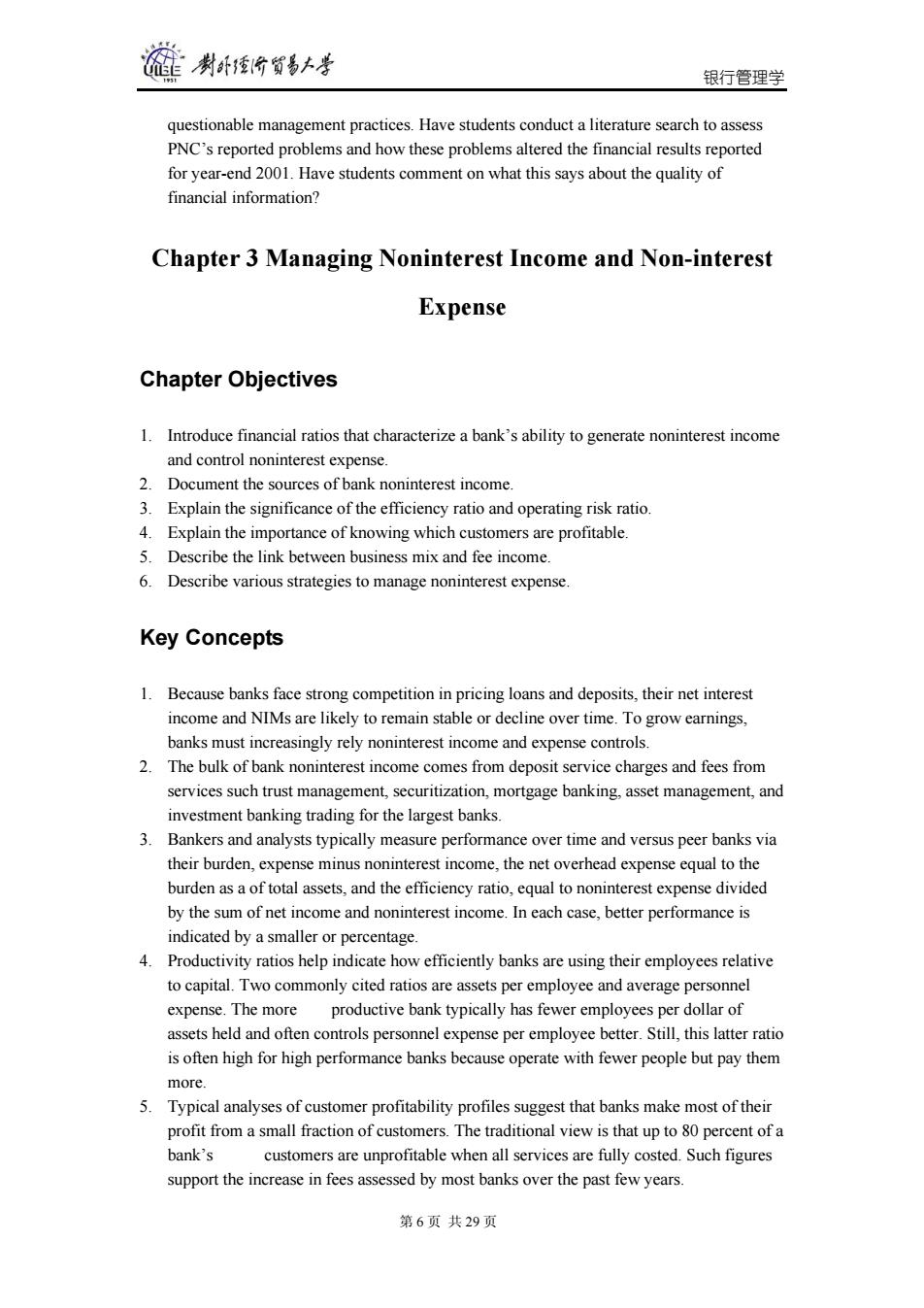
制卧台贸易上考 银行管理学 questionable management practices.Have students conduct a literature search to assess PNC's reported problems and how these problems altered the financial results reported for year-end 2001.Have students comment on what this says about the quality of financial information? Chapter 3 Managing Noninterest Income and Non-interest Expense Chapter Objectives 1.Introduce financial ratios that characterize a bank's ability to generate noninterest income and control noninterest expense 2.Document the sources of bank noninterest income. 3.Explain the significance of the efficiency ratio and operating risk ratio 4.Explain the importance of knowing which customers are profitable. 5.Describe the link between business mix and fee income. 6. Describe various strategies to manage noninterest expense. Key Concepts 1.Because banks face strong competition in pricing loans and deposits,their net interest income and NIMs are likely to remain stable or decline over time.To grow earnings, banks must increasingly rely noninterest income and expense controls. 2.The bulk of bank noninterest income comes from deposit service charges and fees from services such trust management,securitization,mortgage banking,asset management,and investment banking trading for the largest banks. 3.Bankers and analysts typically measure performance over time and versus peer banks via their burden,expense minus noninterest income,the net overhead expense equal to the burden as a of total assets,and the efficiency ratio,equal to noninterest expense divided by the sum of net income and noninterest income.In each case,better performance is indicated by a smaller or percentage. 4.Productivity ratios help indicate how efficiently banks are using their employees relative to capital.Two commonly cited ratios are assets per employee and average personnel expense.The more productive bank typically has fewer employees per dollar of assets held and often controls personnel expense per employee better.Still,this latter ratio is often high for high performance banks because operate with fewer people but pay them more. 5.Typical analyses of customer profitability profiles suggest that banks make most of their profit from a small fraction of customers.The traditional view is that up to 80 percent of a bank's customers are unprofitable when all services are fully costed.Such figures support the increase in fees assessed by most banks over the past few years. 第6页共29页
银行管理学 第 6 页 共 29 页 questionable management practices. Have students conduct a literature search to assess PNC’s reported problems and how these problems altered the financial results reported for year-end 2001. Have students comment on what this says about the quality of financial information? Chapter 3 Managing Noninterest Income and Non-interest Expense Chapter Objectives 1. Introduce financial ratios that characterize a bank’s ability to generate noninterest income and control noninterest expense. 2. Document the sources of bank noninterest income. 3. Explain the significance of the efficiency ratio and operating risk ratio. 4. Explain the importance of knowing which customers are profitable. 5. Describe the link between business mix and fee income. 6. Describe various strategies to manage noninterest expense. Key Concepts 1. Because banks face strong competition in pricing loans and deposits, their net interest income and NIMs are likely to remain stable or decline over time. To grow earnings, banks must increasingly rely noninterest income and expense controls. 2. The bulk of bank noninterest income comes from deposit service charges and fees from services such trust management, securitization, mortgage banking, asset management, and investment banking trading for the largest banks. 3. Bankers and analysts typically measure performance over time and versus peer banks via their burden, expense minus noninterest income, the net overhead expense equal to the burden as a of total assets, and the efficiency ratio, equal to noninterest expense divided by the sum of net income and noninterest income. In each case, better performance is indicated by a smaller or percentage. 4. Productivity ratios help indicate how efficiently banks are using their employees relative to capital. Two commonly cited ratios are assets per employee and average personnel expense. The more productive bank typically has fewer employees per dollar of assets held and often controls personnel expense per employee better. Still, this latter ratio is often high for high performance banks because operate with fewer people but pay them more. 5. Typical analyses of customer profitability profiles suggest that banks make most of their profit from a small fraction of customers. The traditional view is that up to 80 percent of a bank’s customers are unprofitable when all services are fully costed. Such figures support the increase in fees assessed by most banks over the past few years
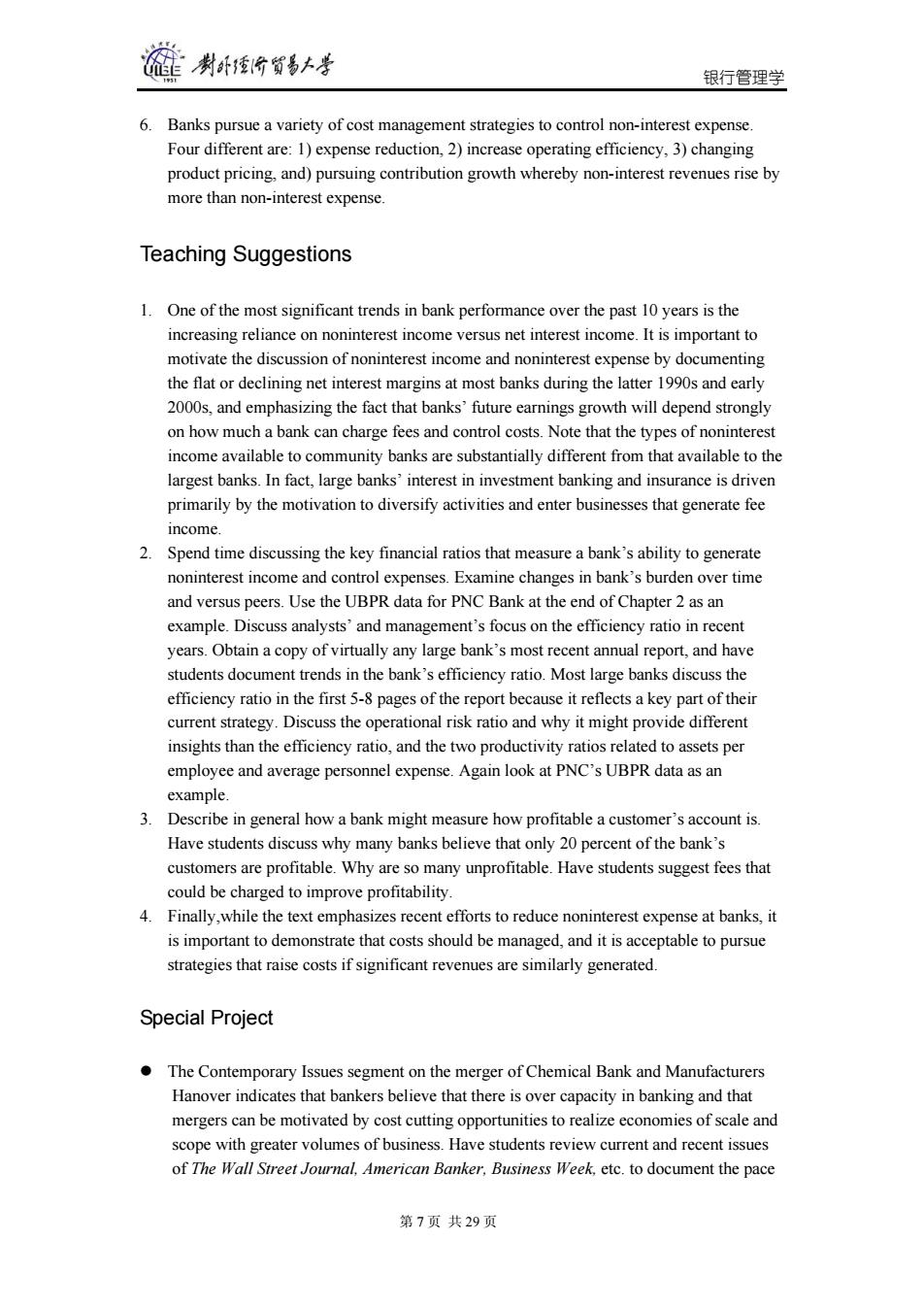
制卧台贸易上兰 银行管理学 6.Banks pursue a variety of cost management strategies to control non-interest expense. Four different are:1)expense reduction,2)increase operating efficiency,3)changing product pricing,and)pursuing contribution growth whereby non-interest revenues rise by more than non-interest expense Teaching Suggestions 1.One of the most significant trends in bank performance over the past 10 years is the increasing reliance on noninterest income versus net interest income.It is important to motivate the discussion of noninterest income and noninterest expense by documenting the flat or declining net interest margins at most banks during the latter 1990s and early 2000s,and emphasizing the fact that banks'future earnings growth will depend strongly on how much a bank can charge fees and control costs.Note that the types of noninterest income available to community banks are substantially different from that available to the largest banks.In fact,large banks'interest in investment banking and insurance is driven primarily by the motivation to diversify activities and enter businesses that generate fee income. 2.Spend time discussing the key financial ratios that measure a bank's ability to generate noninterest income and control expenses.Examine changes in bank's burden over time and versus peers.Use the UBPR data for PNC Bank at the end of Chapter 2 as an example.Discuss analysts'and management's focus on the efficiency ratio in recent years.Obtain a copy of virtually any large bank's most recent annual report,and have students document trends in the bank's efficiency ratio.Most large banks discuss the efficiency ratio in the first 5-8 pages of the report because it reflects a key part of their current strategy.Discuss the operational risk ratio and why it might provide different insights than the efficiency ratio,and the two productivity ratios related to assets per employee and average personnel expense.Again look at PNC's UBPR data as an example. 3.Describe in general how a bank might measure how profitable a customer's account is. Have students discuss why many banks believe that only 20 percent of the bank's customers are profitable.Why are so many unprofitable.Have students suggest fees that could be charged to improve profitability. 4.Finally,while the text emphasizes recent efforts to reduce noninterest expense at banks,it is important to demonstrate that costs should be managed,and it is acceptable to pursue strategies that raise costs if significant revenues are similarly generated. Special Project The Contemporary Issues segment on the merger of Chemical Bank and Manufacturers Hanover indicates that bankers believe that there is over capacity in banking and that mergers can be motivated by cost cutting opportunities to realize economies of scale and scope with greater volumes of business.Have students review current and recent issues of The Wall Street Journal,American Banker,Business Week,etc.to document the pace 第7页共29页
银行管理学 第 7 页 共 29 页 6. Banks pursue a variety of cost management strategies to control non-interest expense. Four different are: 1) expense reduction, 2) increase operating efficiency, 3) changing product pricing, and) pursuing contribution growth whereby non-interest revenues rise by more than non-interest expense. Teaching Suggestions 1. One of the most significant trends in bank performance over the past 10 years is the increasing reliance on noninterest income versus net interest income. It is important to motivate the discussion of noninterest income and noninterest expense by documenting the flat or declining net interest margins at most banks during the latter 1990s and early 2000s, and emphasizing the fact that banks’ future earnings growth will depend strongly on how much a bank can charge fees and control costs. Note that the types of noninterest income available to community banks are substantially different from that available to the largest banks. In fact, large banks’ interest in investment banking and insurance is driven primarily by the motivation to diversify activities and enter businesses that generate fee income. 2. Spend time discussing the key financial ratios that measure a bank’s ability to generate noninterest income and control expenses. Examine changes in bank’s burden over time and versus peers. Use the UBPR data for PNC Bank at the end of Chapter 2 as an example. Discuss analysts’ and management’s focus on the efficiency ratio in recent years. Obtain a copy of virtually any large bank’s most recent annual report, and have students document trends in the bank’s efficiency ratio. Most large banks discuss the efficiency ratio in the first 5-8 pages of the report because it reflects a key part of their current strategy. Discuss the operational risk ratio and why it might provide different insights than the efficiency ratio, and the two productivity ratios related to assets per employee and average personnel expense. Again look at PNC’s UBPR data as an example. 3. Describe in general how a bank might measure how profitable a customer’s account is. Have students discuss why many banks believe that only 20 percent of the bank’s customers are profitable. Why are so many unprofitable. Have students suggest fees that could be charged to improve profitability. 4. Finally,while the text emphasizes recent efforts to reduce noninterest expense at banks, it is important to demonstrate that costs should be managed, and it is acceptable to pursue strategies that raise costs if significant revenues are similarly generated. Special Project z The Contemporary Issues segment on the merger of Chemical Bank and Manufacturers Hanover indicates that bankers believe that there is over capacity in banking and that mergers can be motivated by cost cutting opportunities to realize economies of scale and scope with greater volumes of business. Have students review current and recent issues of The Wall Street Journal, American Banker, Business Week, etc. to document the pace
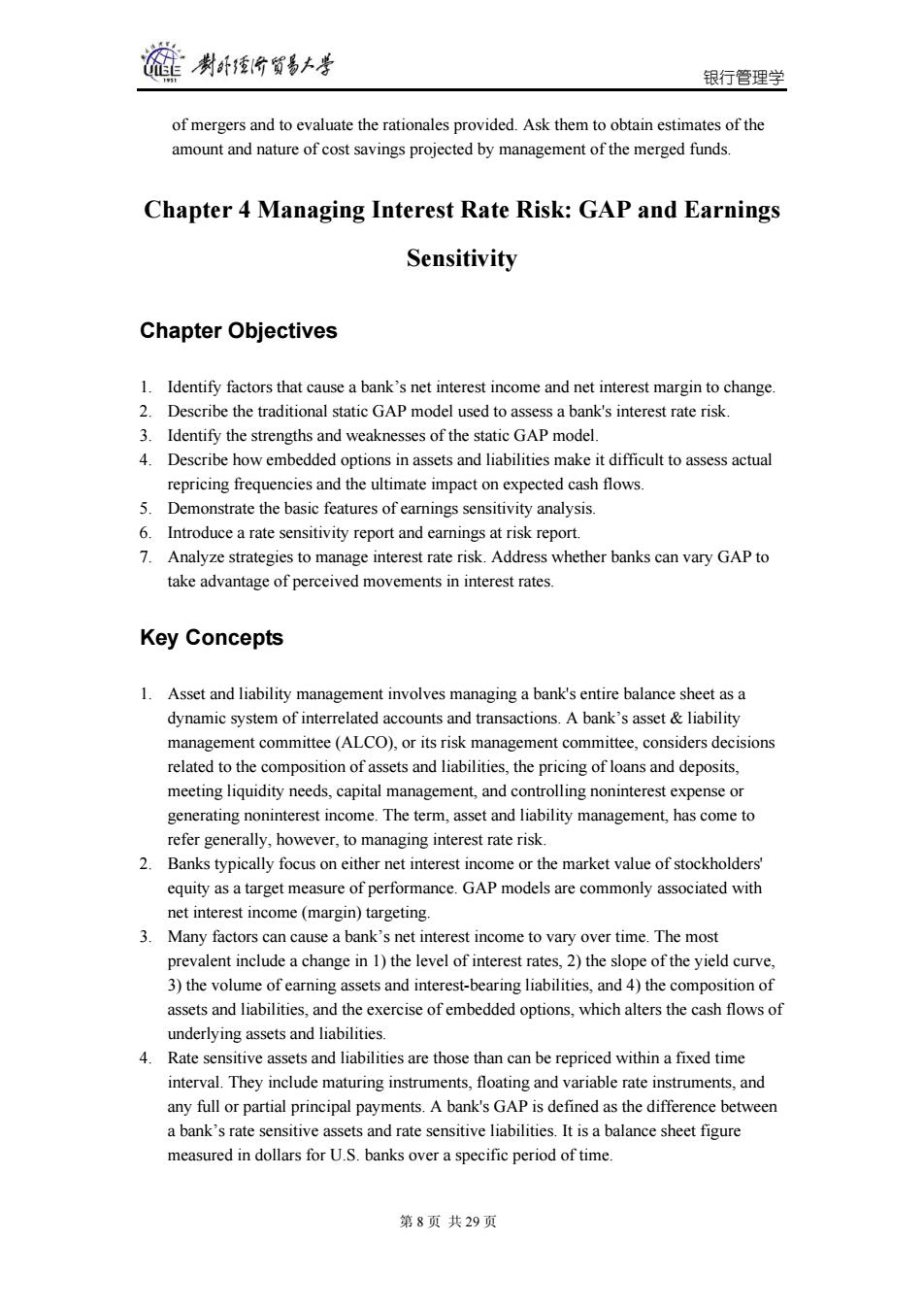
制卧价贸易上孝 银行管理学 of mergers and to evaluate the rationales provided.Ask them to obtain estimates of the amount and nature of cost savings projected by management of the merged funds. Chapter 4 Managing Interest Rate Risk:GAP and Earnings Sensitivity Chapter Objectives 1.Identify factors that cause a bank's net interest income and net interest margin to change. 2.Describe the traditional static GAP model used to assess a bank's interest rate risk. 3.Identify the strengths and weaknesses of the static GAP model. 4.Describe how embedded options in assets and liabilities make it difficult to assess actual repricing frequencies and the ultimate impact on expected cash flows. 5.Demonstrate the basic features of earnings sensitivity analysis. 6.Introduce a rate sensitivity report and earnings at risk report. 7.Analyze strategies to manage interest rate risk.Address whether banks can vary GAP to take advantage of perceived movements in interest rates. Key Concepts 1.Asset and liability management involves managing a bank's entire balance sheet as a dynamic system of interrelated accounts and transactions.A bank's asset liability management committee(ALCO),or its risk management committee,considers decisions related to the composition of assets and liabilities,the pricing of loans and deposits, meeting liquidity needs,capital management,and controlling noninterest expense or generating noninterest income.The term,asset and liability management,has come to refer generally,however,to managing interest rate risk. 2.Banks typically focus on either net interest income or the market value of stockholders' equity as a target measure of performance.GAP models are commonly associated with net interest income (margin)targeting. 3.Many factors can cause a bank's net interest income to vary over time.The most prevalent include a change in 1)the level of interest rates,2)the slope of the yield curve, 3)the volume of earning assets and interest-bearing liabilities,and 4)the composition of assets and liabilities,and the exercise of embedded options,which alters the cash flows of underlying assets and liabilities. 4.Rate sensitive assets and liabilities are those than can be repriced within a fixed time interval.They include maturing instruments,floating and variable rate instruments,and any full or partial principal payments.A bank's GAP is defined as the difference between a bank's rate sensitive assets and rate sensitive liabilities.It is a balance sheet figure measured in dollars for U.S.banks over a specific period of time. 第8页共29页
银行管理学 第 8 页 共 29 页 of mergers and to evaluate the rationales provided. Ask them to obtain estimates of the amount and nature of cost savings projected by management of the merged funds. Chapter 4 Managing Interest Rate Risk: GAP and Earnings Sensitivity Chapter Objectives 1. Identify factors that cause a bank’s net interest income and net interest margin to change. 2. Describe the traditional static GAP model used to assess a bank's interest rate risk. 3. Identify the strengths and weaknesses of the static GAP model. 4. Describe how embedded options in assets and liabilities make it difficult to assess actual repricing frequencies and the ultimate impact on expected cash flows. 5. Demonstrate the basic features of earnings sensitivity analysis. 6. Introduce a rate sensitivity report and earnings at risk report. 7. Analyze strategies to manage interest rate risk. Address whether banks can vary GAP to take advantage of perceived movements in interest rates. Key Concepts 1. Asset and liability management involves managing a bank's entire balance sheet as a dynamic system of interrelated accounts and transactions. A bank’s asset & liability management committee (ALCO), or its risk management committee, considers decisions related to the composition of assets and liabilities, the pricing of loans and deposits, meeting liquidity needs, capital management, and controlling noninterest expense or generating noninterest income. The term, asset and liability management, has come to refer generally, however, to managing interest rate risk. 2. Banks typically focus on either net interest income or the market value of stockholders' equity as a target measure of performance. GAP models are commonly associated with net interest income (margin) targeting. 3. Many factors can cause a bank’s net interest income to vary over time. The most prevalent include a change in 1) the level of interest rates, 2) the slope of the yield curve, 3) the volume of earning assets and interest-bearing liabilities, and 4) the composition of assets and liabilities, and the exercise of embedded options, which alters the cash flows of underlying assets and liabilities. 4. Rate sensitive assets and liabilities are those than can be repriced within a fixed time interval. They include maturing instruments, floating and variable rate instruments, and any full or partial principal payments. A bank's GAP is defined as the difference between a bank’s rate sensitive assets and rate sensitive liabilities. It is a balance sheet figure measured in dollars for U.S. banks over a specific period of time
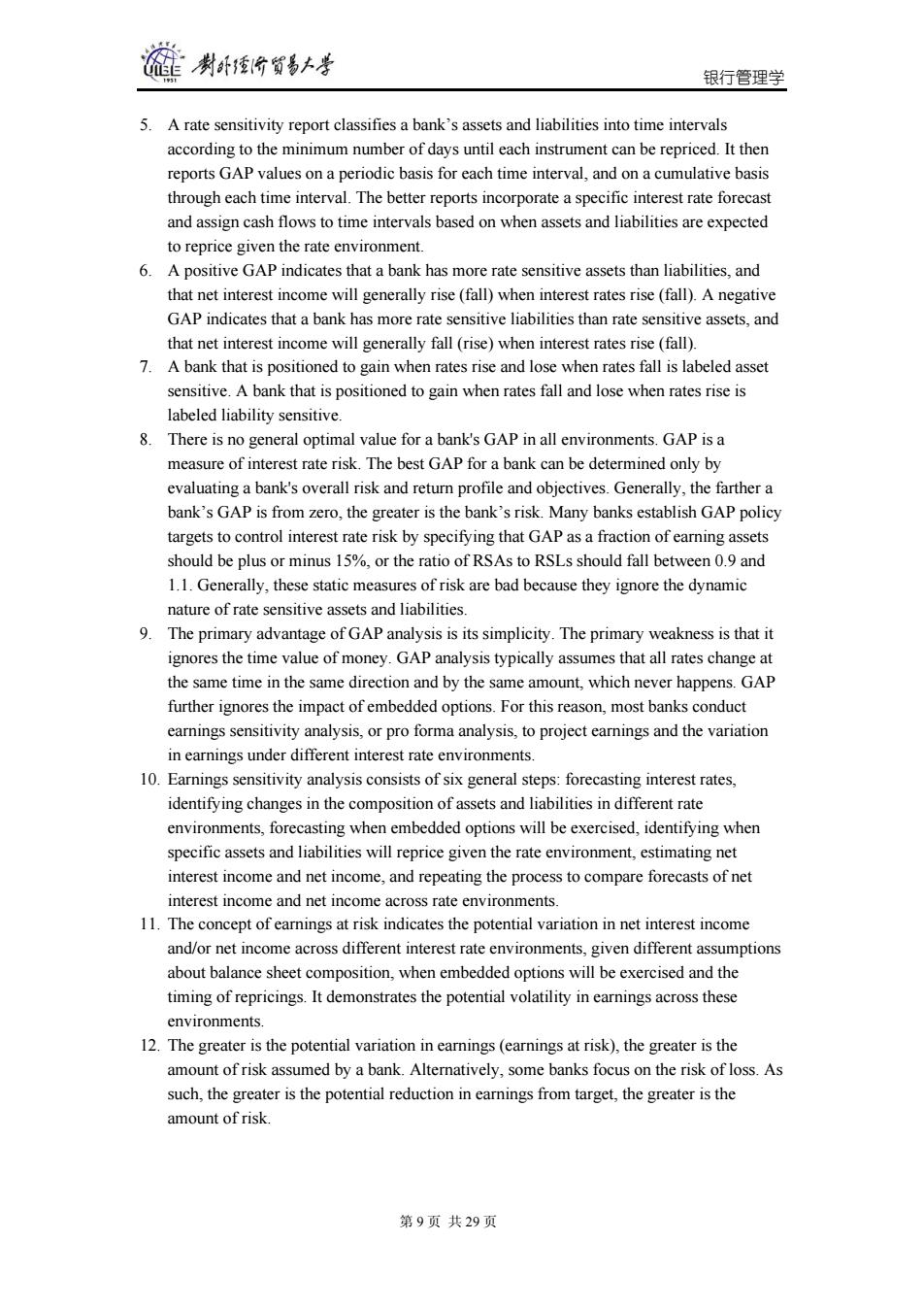
制卧台贸易上兰 银行管理学 5.A rate sensitivity report classifies a bank's assets and liabilities into time intervals according to the minimum number of days until each instrument can be repriced.It then reports GAP values on a periodic basis for each time interval,and on a cumulative basis through each time interval.The better reports incorporate a specific interest rate forecast and assign cash flows to time intervals based on when assets and liabilities are expected to reprice given the rate environment. 6.A positive GAP indicates that a bank has more rate sensitive assets than liabilities,and that net interest income will generally rise (fall)when interest rates rise (fall).A negative GAP indicates that a bank has more rate sensitive liabilities than rate sensitive assets,and that net interest income will generally fall(rise)when interest rates rise(fall). 7.A bank that is positioned to gain when rates rise and lose when rates fall is labeled asset sensitive.A bank that is positioned to gain when rates fall and lose when rates rise is labeled liability sensitive. 8.There is no general optimal value for a bank's GAP in all environments.GAP is a measure of interest rate risk.The best GAP for a bank can be determined only by evaluating a bank's overall risk and return profile and objectives.Generally,the farther a bank's GAP is from zero,the greater is the bank's risk.Many banks establish GAP policy targets to control interest rate risk by specifying that GAP as a fraction of earning assets should be plus or minus 15%,or the ratio of RSAs to RSLs should fall between 0.9 and 1.1.Generally,these static measures of risk are bad because they ignore the dynamic nature of rate sensitive assets and liabilities. 9.The primary advantage of GAP analysis is its simplicity.The primary weakness is that it ignores the time value of money.GAP analysis typically assumes that all rates change at the same time in the same direction and by the same amount,which never happens.GAP further ignores the impact of embedded options.For this reason,most banks conduct earnings sensitivity analysis,or pro forma analysis,to project earnings and the variation in earnings under different interest rate environments. 10.Earnings sensitivity analysis consists of six general steps:forecasting interest rates, identifying changes in the composition of assets and liabilities in different rate environments,forecasting when embedded options will be exercised,identifying when specific assets and liabilities will reprice given the rate environment,estimating net interest income and net income,and repeating the process to compare forecasts of net interest income and net income across rate environments. 11.The concept of earnings at risk indicates the potential variation in net interest income and/or net income across different interest rate environments,given different assumptions about balance sheet composition,when embedded options will be exercised and the timing of repricings.It demonstrates the potential volatility in earnings across these environments. 12.The greater is the potential variation in earnings(earnings at risk),the greater is the amount of risk assumed by a bank.Alternatively,some banks focus on the risk of loss.As such,the greater is the potential reduction in earnings from target,the greater is the amount of risk. 第9页共29页
银行管理学 第 9 页 共 29 页 5. A rate sensitivity report classifies a bank’s assets and liabilities into time intervals according to the minimum number of days until each instrument can be repriced. It then reports GAP values on a periodic basis for each time interval, and on a cumulative basis through each time interval. The better reports incorporate a specific interest rate forecast and assign cash flows to time intervals based on when assets and liabilities are expected to reprice given the rate environment. 6. A positive GAP indicates that a bank has more rate sensitive assets than liabilities, and that net interest income will generally rise (fall) when interest rates rise (fall). A negative GAP indicates that a bank has more rate sensitive liabilities than rate sensitive assets, and that net interest income will generally fall (rise) when interest rates rise (fall). 7. A bank that is positioned to gain when rates rise and lose when rates fall is labeled asset sensitive. A bank that is positioned to gain when rates fall and lose when rates rise is labeled liability sensitive. 8. There is no general optimal value for a bank's GAP in all environments. GAP is a measure of interest rate risk. The best GAP for a bank can be determined only by evaluating a bank's overall risk and return profile and objectives. Generally, the farther a bank’s GAP is from zero, the greater is the bank’s risk. Many banks establish GAP policy targets to control interest rate risk by specifying that GAP as a fraction of earning assets should be plus or minus 15%, or the ratio of RSAs to RSLs should fall between 0.9 and 1.1. Generally, these static measures of risk are bad because they ignore the dynamic nature of rate sensitive assets and liabilities. 9. The primary advantage of GAP analysis is its simplicity. The primary weakness is that it ignores the time value of money. GAP analysis typically assumes that all rates change at the same time in the same direction and by the same amount, which never happens. GAP further ignores the impact of embedded options. For this reason, most banks conduct earnings sensitivity analysis, or pro forma analysis, to project earnings and the variation in earnings under different interest rate environments. 10. Earnings sensitivity analysis consists of six general steps: forecasting interest rates, identifying changes in the composition of assets and liabilities in different rate environments, forecasting when embedded options will be exercised, identifying when specific assets and liabilities will reprice given the rate environment, estimating net interest income and net income, and repeating the process to compare forecasts of net interest income and net income across rate environments. 11. The concept of earnings at risk indicates the potential variation in net interest income and/or net income across different interest rate environments, given different assumptions about balance sheet composition, when embedded options will be exercised and the timing of repricings. It demonstrates the potential volatility in earnings across these environments. 12. The greater is the potential variation in earnings (earnings at risk), the greater is the amount of risk assumed by a bank. Alternatively, some banks focus on the risk of loss. As such, the greater is the potential reduction in earnings from target, the greater is the amount of risk
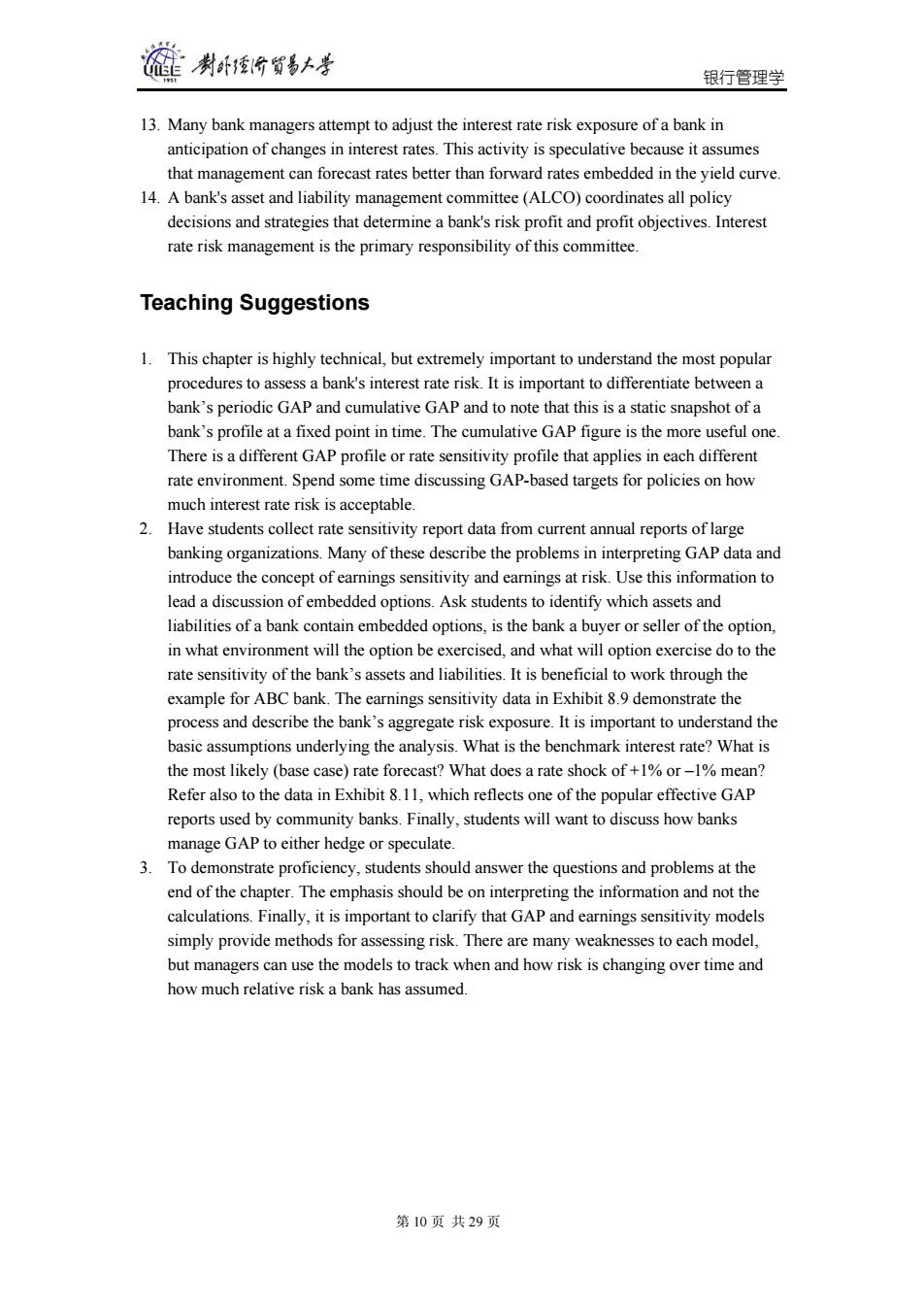
制卧台贸易上兰 银行管理学 13.Many bank managers attempt to adjust the interest rate risk exposure of a bank in anticipation of changes in interest rates.This activity is speculative because it assumes that management can forecast rates better than forward rates embedded in the yield curve. 14.A bank's asset and liability management committee (ALCO)coordinates all policy decisions and strategies that determine a bank's risk profit and profit objectives.Interest rate risk management is the primary responsibility of this committee. Teaching Suggestions 1.This chapter is highly technical,but extremely important to understand the most popular procedures to assess a bank's interest rate risk.It is important to differentiate between a bank's periodic GAP and cumulative GAP and to note that this is a static snapshot of a bank's profile at a fixed point in time.The cumulative GAP figure is the more useful one. There is a different GAP profile or rate sensitivity profile that applies in each different rate environment.Spend some time discussing GAP-based targets for policies on how much interest rate risk is acceptable. 2.Have students collect rate sensitivity report data from current annual reports of large banking organizations.Many of these describe the problems in interpreting GAP data and introduce the concept of earnings sensitivity and earnings at risk.Use this information to lead a discussion of embedded options.Ask students to identify which assets and liabilities of a bank contain embedded options,is the bank a buyer or seller of the option, in what environment will the option be exercised,and what will option exercise do to the rate sensitivity of the bank's assets and liabilities.It is beneficial to work through the example for ABC bank.The earnings sensitivity data in Exhibit 8.9 demonstrate the process and describe the bank's aggregate risk exposure.It is important to understand the basic assumptions underlying the analysis.What is the benchmark interest rate?What is the most likely (base case)rate forecast?What does a rate shock of +1%or-1%mean? Refer also to the data in Exhibit 8.11,which reflects one of the popular effective GAP reports used by community banks.Finally,students will want to discuss how banks manage GAP to either hedge or speculate. 3.To demonstrate proficiency,students should answer the questions and problems at the end of the chapter.The emphasis should be on interpreting the information and not the calculations.Finally,it is important to clarify that GAP and earnings sensitivity models simply provide methods for assessing risk.There are many weaknesses to each model, but managers can use the models to track when and how risk is changing over time and how much relative risk a bank has assumed. 第10页共29页
银行管理学 第 10 页 共 29 页 13. Many bank managers attempt to adjust the interest rate risk exposure of a bank in anticipation of changes in interest rates. This activity is speculative because it assumes that management can forecast rates better than forward rates embedded in the yield curve. 14. A bank's asset and liability management committee (ALCO) coordinates all policy decisions and strategies that determine a bank's risk profit and profit objectives. Interest rate risk management is the primary responsibility of this committee. Teaching Suggestions 1. This chapter is highly technical, but extremely important to understand the most popular procedures to assess a bank's interest rate risk. It is important to differentiate between a bank’s periodic GAP and cumulative GAP and to note that this is a static snapshot of a bank’s profile at a fixed point in time. The cumulative GAP figure is the more useful one. There is a different GAP profile or rate sensitivity profile that applies in each different rate environment. Spend some time discussing GAP-based targets for policies on how much interest rate risk is acceptable. 2. Have students collect rate sensitivity report data from current annual reports of large banking organizations. Many of these describe the problems in interpreting GAP data and introduce the concept of earnings sensitivity and earnings at risk. Use this information to lead a discussion of embedded options. Ask students to identify which assets and liabilities of a bank contain embedded options, is the bank a buyer or seller of the option, in what environment will the option be exercised, and what will option exercise do to the rate sensitivity of the bank’s assets and liabilities. It is beneficial to work through the example for ABC bank. The earnings sensitivity data in Exhibit 8.9 demonstrate the process and describe the bank’s aggregate risk exposure. It is important to understand the basic assumptions underlying the analysis. What is the benchmark interest rate? What is the most likely (base case) rate forecast? What does a rate shock of +1% or –1% mean? Refer also to the data in Exhibit 8.11, which reflects one of the popular effective GAP reports used by community banks. Finally, students will want to discuss how banks manage GAP to either hedge or speculate. 3. To demonstrate proficiency, students should answer the questions and problems at the end of the chapter. The emphasis should be on interpreting the information and not the calculations. Finally, it is important to clarify that GAP and earnings sensitivity models simply provide methods for assessing risk. There are many weaknesses to each model, but managers can use the models to track when and how risk is changing over time and how much relative risk a bank has assumed